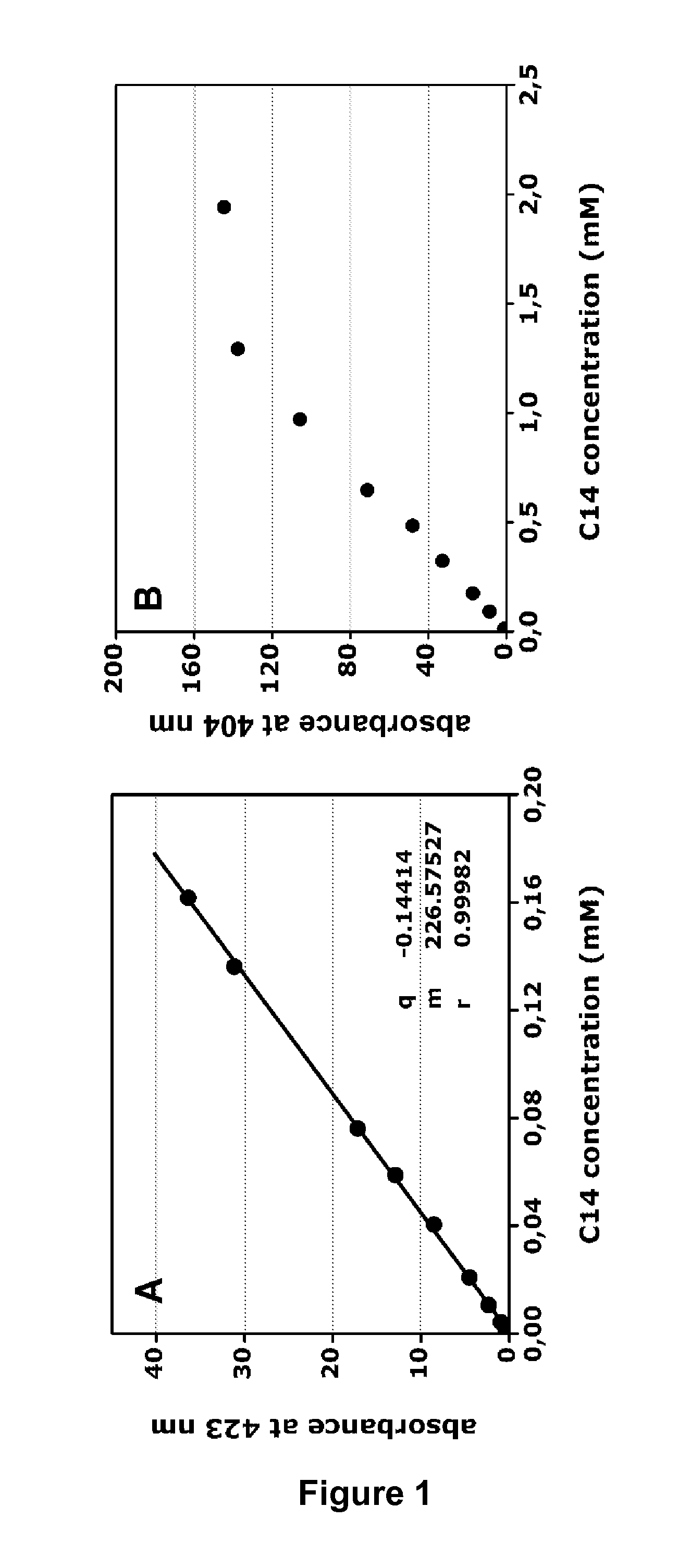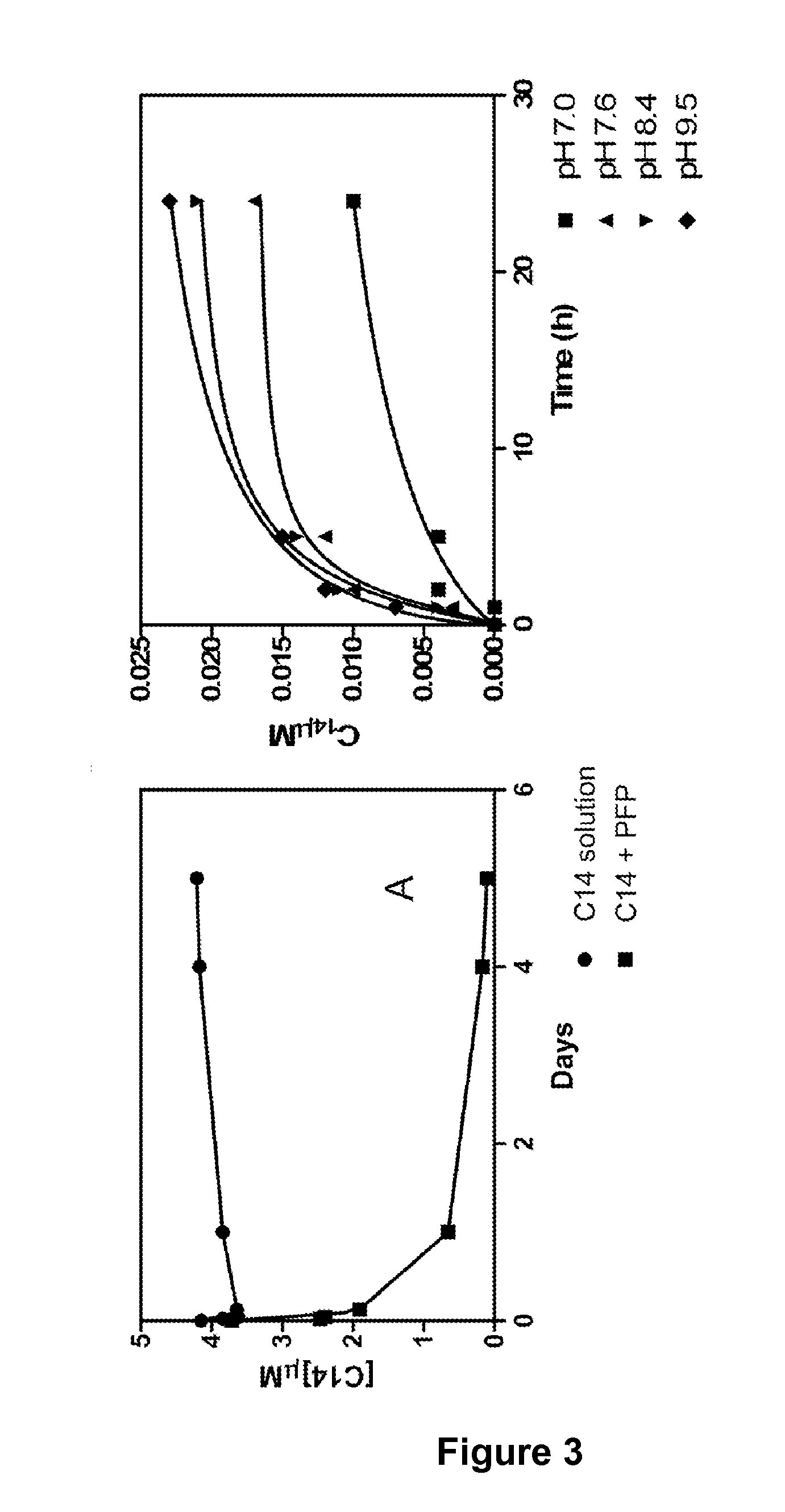Composition comprising a photoactivatable larvicide
a larvicide and photoactivation technology, applied in the field of insecticides, can solve the problems of adverse effects on non-target biota, inducing resistance in target insect populations, and human health and environmental health risks,
- Summary
- Abstract
- Description
- Claims
- Application Information
AI Technical Summary
Benefits of technology
Problems solved by technology
Method used
Image
Examples
example 1
Efficacy as Mosquito Larvicide
[0184]Laboratory strains of Anopheles stephensi, M and S (Kisumu), chromosomal forms of An. gambiae, An. arabiensis and Aedes aegypti, as well as field-collected Anopheles spp. and Aedes spp. larvae were used. Laboratory mosquitoes were maintained at 28-30° C., >90% RH and a photoperiod of 12 h. Light intensity ranged between 0.5 mW / cm2 (fluorescent lamp) and 185 mW / cm2 (sunlight).
[0185]C12 or C14 porphyrin solutions at 5-100 μM concentrations were pre-incubated at room temperature in the darkness with 15-60 mg of carrier (either Eudragit or ground mouse food or cat food) for 4-12 hours under gentle shaking. After incubation the solutions were filtered, and the loaded carrier was dried at room temperature or in an oven (45° C.).
[0186]Eudragit was Eudragit S100® (Evonik Industries AG, Essen, Germany).
[0187]The binding efficacy of porphyrin to Eudragit is about 95%, with respect to the initial quantity of porphyrin dissolved in the incubation solution. Fo...
example 2
Ingestion of Por-Eud by Larvae and Photosensitizing Effect of the Ingested Formulate
[0192]The photosensitizing effect of ingested Por-Eud, wherein Por means porphyrin C12 and Eud means Eudragit S100® (Evonik Industries AG, Essen, Germany), on mosquito larvae was demonstrated in experiments conducted in the laboratory using Anopheles gambiae Kisumu strain, all larval stages and the results are shown in table 4. Larvae were fed overnight with untreated Eudragit (Eud control) or with porphyrin-loaded Eudragit and then exposed to sunlight. Treated larvae were exposed to light either in the same tray where the overnight feeding occurred (Por-Eud), or after being transferred to trays containing clean water (Por-Eud tray change). Additionally, a batch of larvae was added to filtered water from trays that were incubated overnight with Por-Eud (Por-Eud water).
[0193]Table 4 shows the mortality of larvae fed with Por-Eud overnight and exposed to sunlight in Por-Eud treated water trays or in tr...
example 3
Larval Instars Uptake of Porphyrin Loaded on a Carrier
[0195]Direct observations were made under the stereomicroscope of An. stephensi and Ae. aegypti larvae fed with porphyrin loaded on animal pellets, being mouse and cat food (Mucedola Srl, Italy and Friskies®) or Eudragit, being Eudragit S100® (Evonik Industries AG, Essen, Germany).
[0196]Anopheles stephensi and Aedes aegypti larvae in all stages of larval development were offered porphyrin loaded on animal pellets or Eudragit, both containing particles of different diameter (1-300 μm). An. stephensi larvae ingest preferentially food particles floating on water surface, while Aedes larvae feed on the bottom of the containers. Larvae take up preferably particles in the range of 20-50 μm. Examining larvae guts at the microscope revealed that the majority of the particles visible in the gut lumen measure between 6 and 20 μm. The difference in particle range observed at uptake and within the gut might be explained by a break down or di...
PUM
| Property | Measurement | Unit |
|---|---|---|
| Temperature | aaaaa | aaaaa |
| Fraction | aaaaa | aaaaa |
| Fraction | aaaaa | aaaaa |
Abstract
Description
Claims
Application Information
 Login to View More
Login to View More - R&D
- Intellectual Property
- Life Sciences
- Materials
- Tech Scout
- Unparalleled Data Quality
- Higher Quality Content
- 60% Fewer Hallucinations
Browse by: Latest US Patents, China's latest patents, Technical Efficacy Thesaurus, Application Domain, Technology Topic, Popular Technical Reports.
© 2025 PatSnap. All rights reserved.Legal|Privacy policy|Modern Slavery Act Transparency Statement|Sitemap|About US| Contact US: help@patsnap.com



